The Marriage-go-round: the State of Marriage and the Family in America Today
This is "Family Patterns in the United States Today", section xi.3 from the book Sociology: Brief Edition (five. ane.0). For details on it (including licensing), click here.
This book is licensed under a Creative Commons by-nc-sa iii.0 license. Encounter the license for more details, just that basically ways you can share this book as long as yous credit the author (but see below), don't make money from it, and do make it available to everyone else under the same terms.
This content was accessible equally of December 29, 2012, and it was downloaded then by Andy Schmitz in an attempt to preserve the availability of this book.
Normally, the author and publisher would be credited here. However, the publisher has asked for the customary Creative Commons attribution to the original publisher, authors, title, and volume URI to be removed. Additionally, per the publisher's request, their proper name has been removed in some passages. More information is available on this project's attribution page.
For more information on the source of this book, or why it is bachelor for free, delight see the project's dwelling house page. You can scan or download additional books there. To download a .zip file containing this volume to use offline, only click here.
Has this book helped you? Consider passing information technology on:

Creative Commons supports free civilisation from music to educational activity. Their licenses helped brand this book bachelor to yous.

DonorsChoose.org helps people like you lot assist teachers fund their classroom projects, from art supplies to books to calculators.
eleven.3 Family unit Patterns in the United States Today
Learning Objectives
- Describe the major marriage and family arrangements in the Usa today.
- Hash out racial and ethnic differences in marriage and family arrangements.
It is time now to take a closer await at families in the United States today. Using U.S. Census data (U.S. Demography Bureau, 2010),U.South. Census Bureau. (2010). Statistical abstract of the United States: 2010. Washington, DC: U.Southward. Regime Printing Role. Retrieved from http://world wide web.census.gov/compendia/statab nosotros first sketch the major types of family arrangements that now exist.
Union
The census defines a household equally being all the people who live together in a home unit, whether or not they are related by blood, marriage, or adoption. About 117 1000000 households exist in the United States. Of this number, about 67% are family households and 33% are nonfamily households. Most of the nonfamily households consist of only one person. About half of all households involve a married couple, and half do not involve a married couple.
This last figure should not suggest that marriage is unimportant. But 26% of all adults (xviii or older) have never been married; most 57% are currently married; x% are divorced; and 6% are widowed (see Figure 11.4 "Marital Status of the U.Southward. Population, 2008, Persons 18 Years of Age or Older"). Because more than half of the never-married people are under 30, it is fair to say that many of them volition be getting married onetime in the future. When we look just at people ages 45–54, about 88% are currently married or had been married at some betoken in their lives. These figures all indicate that marriage remains an important ideal in American life, even if non all marriages succeed.
Figure 11.4 Marital Status of the U.Due south. Population, 2008, Persons 18 Years of Age or Older
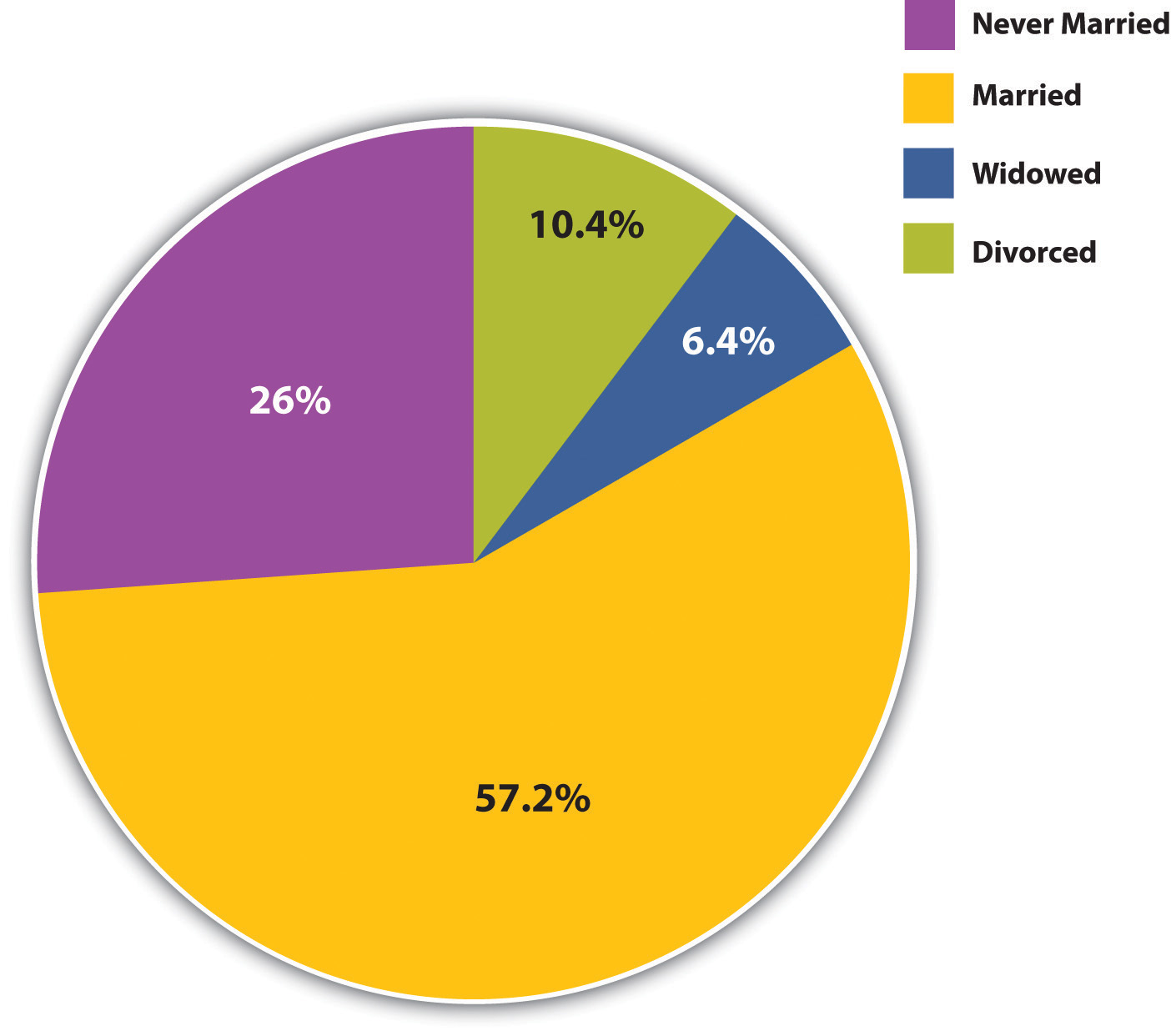
Source: Data from U.South. Census Bureau. (2010). Statistical abstract of the United States: 2010. Washington, DC: U.S. Authorities Printing Office. Retrieved from http://www.census.gov/compendia/statab.
Figure eleven.5
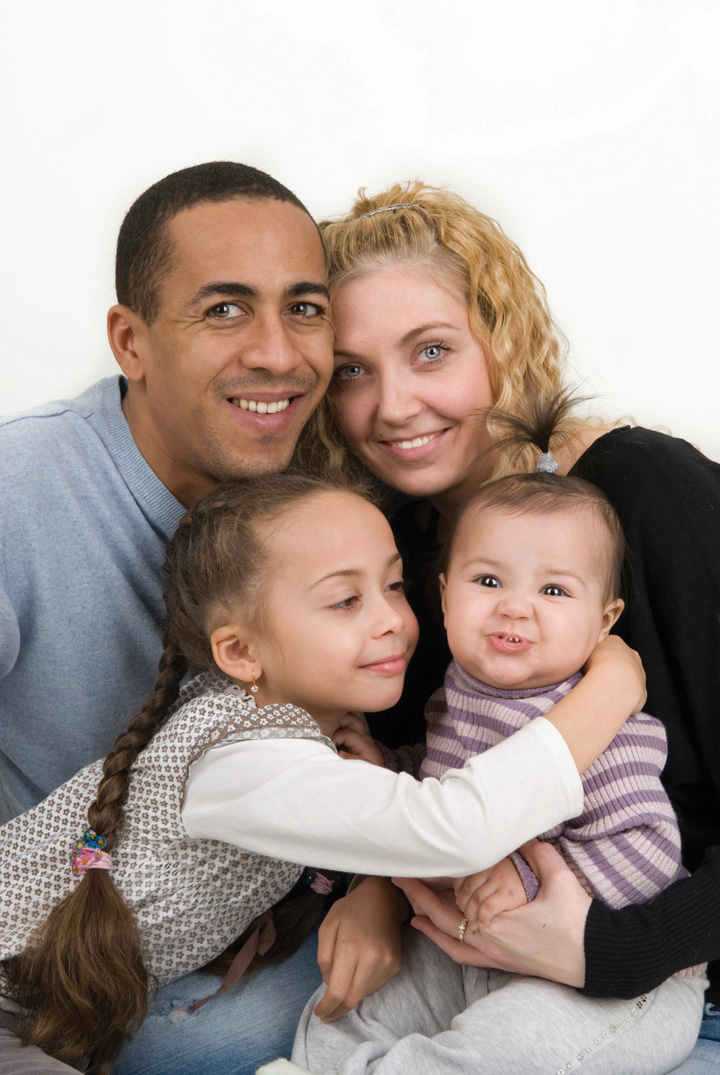
Although only 3.ix% of marriages are between people of unlike races, this figure is three times greater than the proportion of marriages in 1980 that were interracial.
© Thinkstock
Virtually marriages (96.1%) are intraracial, or between people of the same race, with only 3.ix% of marriages between people of dissimilar races. As modest as it is, this figure is iii times greater than the one.3% of marriages in 1980 that were interracial. Moreover, almost fifteen% of new marriages in 2008 were interracial. This increment (Chen, 2010)Chen, Due south. (2010, June 4). Interracial marriages at an all-fourth dimension high, study says. CNN. Retrieved from http://www.cnn.com/2010/LIVING/06/04/pew.interracial.wedlock is reflected in dating patterns, every bit more than half of African American, Latino, and Asian adults accept dated someone from a different racial/ethnic group (Qian, 2005).Qian, Z. (2005). Breaking the final taboo: Interracial marriage in America. Contexts, 4(four), 33–37. More than than half of married Asians and Native Americans are in an interracial wedlock, compared to about 40% of Latinos, ten% of African Americans, and 4% of whites. These percentages heavily reflect the numbers of people in these groups, because mathematically information technology is easiest to terminate upwardly in an interracial relationship and matrimony if there are relatively few people in one's own racial/ethnic group. Considering there are so many whites compared to the other groups, more than 90% of all interracial marriages have a white spouse.
It is interesting to see how the age at which people first get married has changed. Figure 11.half-dozen "Median Age at First Marriage for Men and Women, 1890–2009" shows that age at first spousal relationship declined gradually during the first half of the 20th century, before dropping more sharply between 1940 and 1950 considering of Globe War Two. It then rose afterwards 1970 and today stands at nigh 28 years for men and 26 years for women.
Figure 11.six Median Historic period at First Marriage for Men and Women, 1890–2009
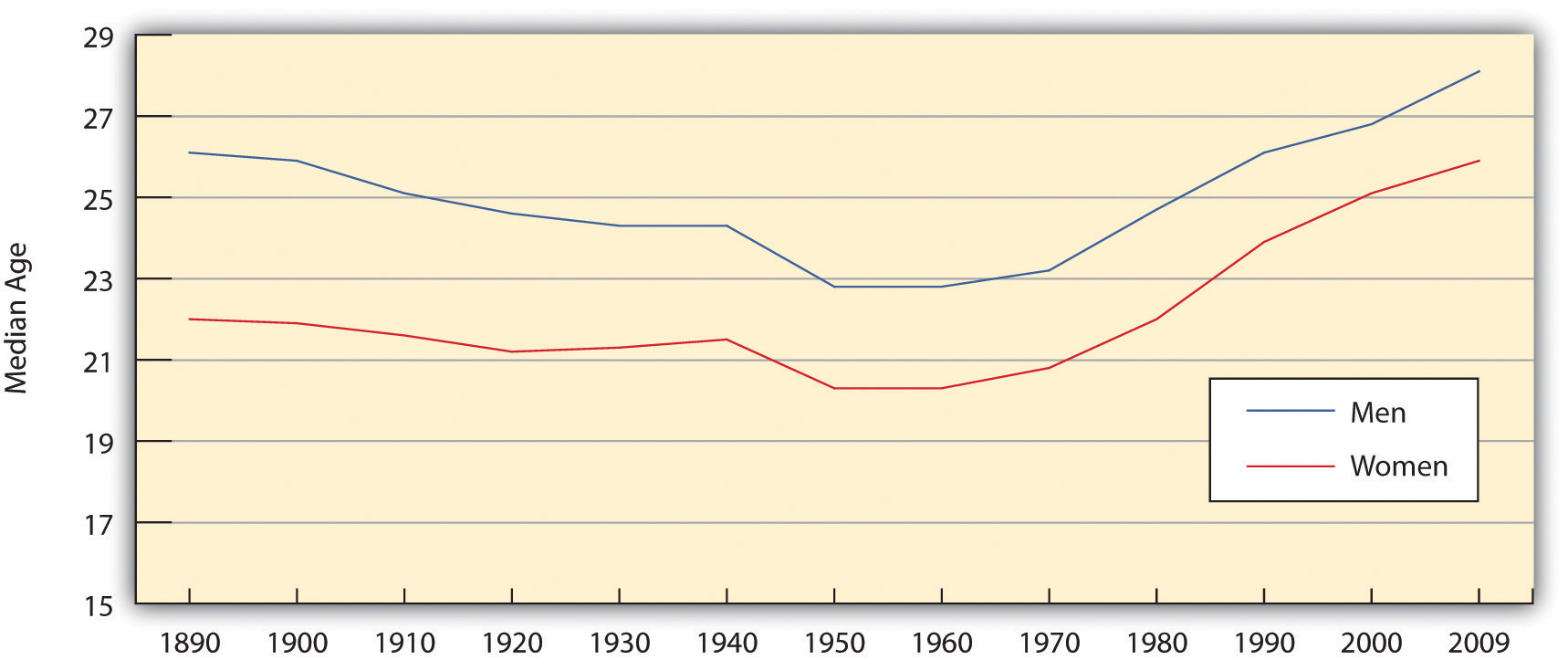
The Us Compared With Other Western Nations
In many ways the United States differs from other Western democracies in its view of union and in its behavior involving marriage and other intimate relationships (Cherlin, 2010; Hull, Meier, & Ortyl, 2010).Cherlin, A. J. (2010). The spousal relationship-go-circular: The state of spousal relationship and the family in America today. New York, NY: Vintage; Hull, K. Eastward., Meier, A., & Ortyl, T. (2010). The changing landscape of dear and marriage. Contexts, 9(2), 32–37. First, Americans place more emphasis than their Western counterparts on the ideal of romantic love equally a basis for union and other intimate relationships and on the cultural importance of spousal relationship. Second, the United States has higher rates of marriage than other Western nations. Tertiary, the United States too has higher rates of divorce than other Western nations; for example, 42% of American marriages end in divorce after 15 years, compared to only 8% in Italian republic and Spain. Fourth, Americans are much more probable than other Western citizens to remarry once they are divorced, to cohabit in brusk-term relationships, and, in full general, to move from 1 intimate relationship to another, a exercise called serial monogamy. This practice leads to instability that can have negative impacts on any children that may exist involved and also on the adults involved.
The U.Due south. emphasis on romantic beloved helps account for its high rates of marriage, divorce, and serial monogamy. It leads people to want to be in an intimate relationship, marital or cohabiting. And then, when couples get married because they are in love, many apace detect that passionate romantic love can quickly fade; because their expectations of romantic dear were so high, they become that more than disenchanted once this happens and unhappy in their spousal relationship. The American emphasis on independence and individualism also makes divorce more likely than in other nations; if a marriage is non good for united states of america, we practice what is best for the states equally individuals and cease the marriage. As Andrew J. Cherlin (2010, p. four)Cherlin, A. J. (2010). The wedlock-get-circular: The land of marriage and the family in America today. New York, NY: Vintage. observes, "Americans are conflicted almost lifelong marriage: they value the stability and security of marriage, merely they tend to believe that individuals who are unhappy with their marriages should be allowed to end them." Still the ideal of romantic honey persists even afterward divorce, leading to remarriage and/or other intimate relationships.
Families and Children in the United States
The United States has virtually 36 million families with children nether 18. About seventy% of these are married-couple families, while xxx% (up from about 14% in the 1950s) are one-parent families. Most of these latter families are headed past the mother (encounter Figure xi.seven "Family Households With Children Under 18 Years of Historic period, 2008").
Figure eleven.seven Family Households With Children Under 18 Years of Age, 2008
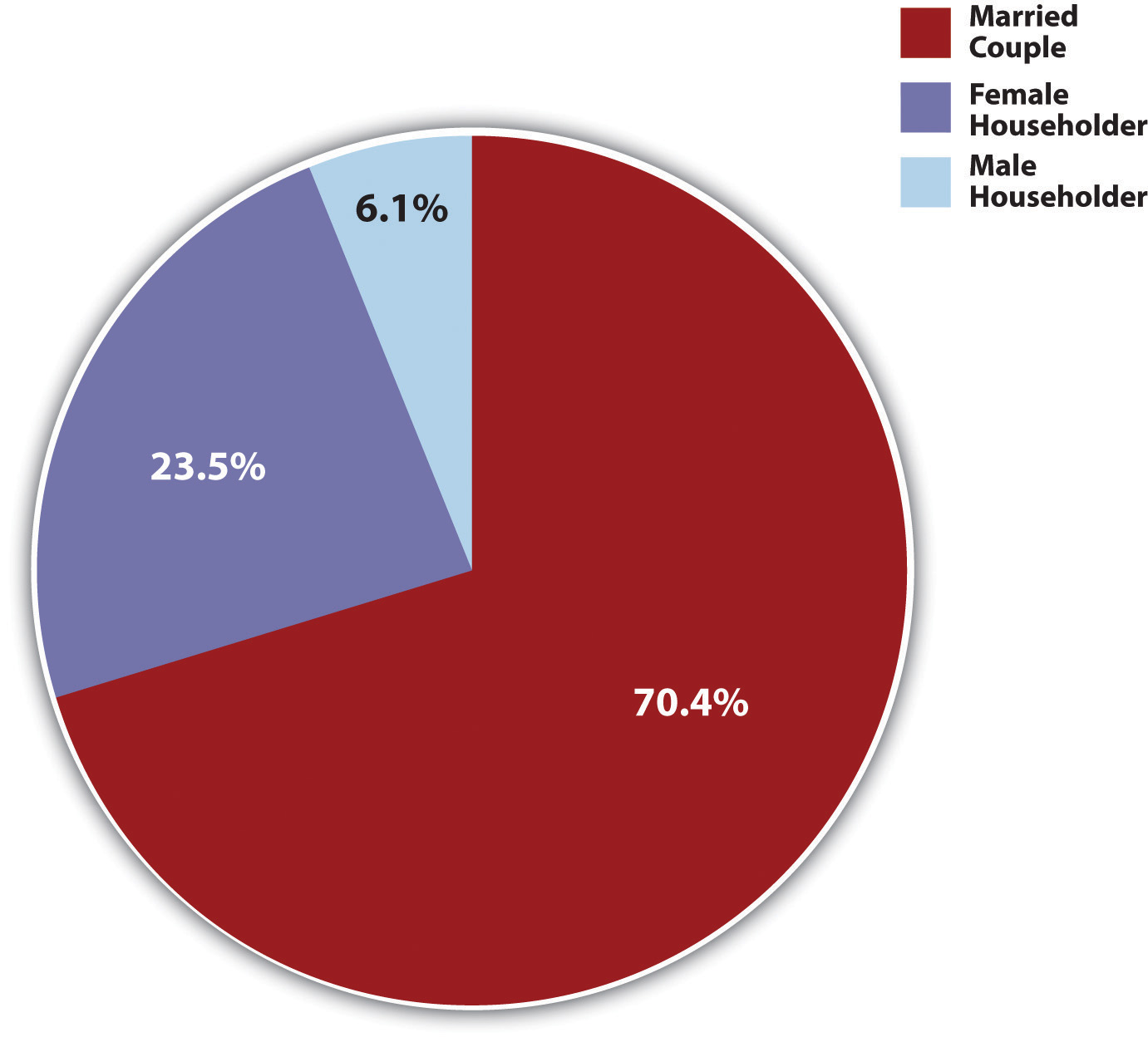
Source: Data from U.S. Census Bureau. (2010). Statistical abstruse of the Us: 2010. Washington, DC: U.Due south. Government Printing Office. Retrieved from http://www.demography.gov/compendia/statab.
The proportion of families with children nether 18 that have simply one parent varies significantly past race and ethnicity: Latino and African American families are more than likely than white and Asian American households to have only i parent (run into Figure 11.8 "Race, Ethnicity, and Percentage of Family unit Groups With Only Ane Parent, 2008"). Similarly, whereas 30% of all children practise not alive with both their biological parents, this figure, too, varies by race and ethnicity: 22% for non-Latino white children, compared to fifteen% of Asian children, thirty% of Latino children, and 62.5% of African American children.
Figure 11.8 Race, Ethnicity, and Percentage of Family Groups With Just 1 Parent, 2008
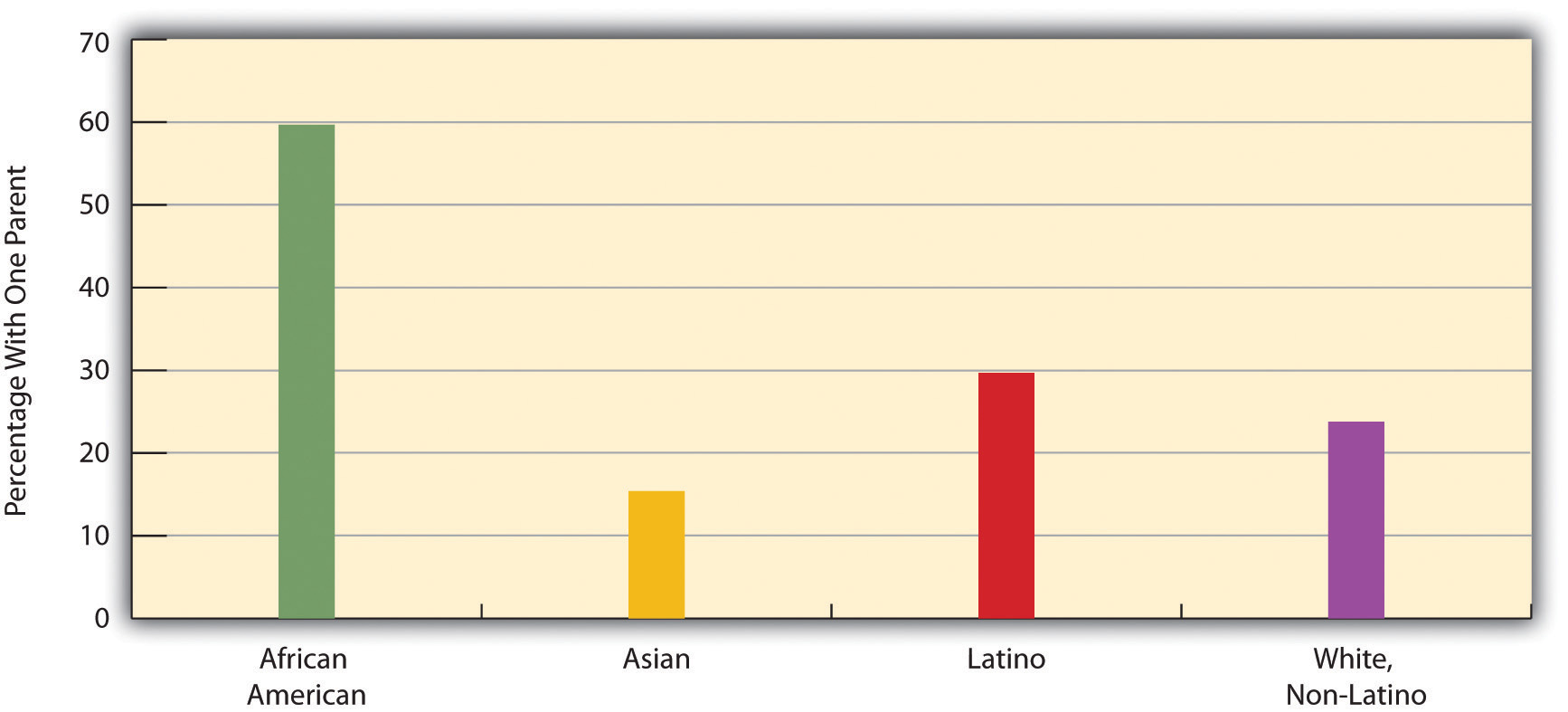
Source: Data from U.S. Census Bureau. (2010). Statistical abstruse of the United States: 2010. Washington, DC: U.S. Government Printing Office. Retrieved from http://world wide web.census.gov/compendia/statab.
We discuss unmarried-parent families and racial and indigenous differences in family arrangements at greater length a little subsequently, and nosotros will as well discuss several other problems affecting children. Simply before nosotros leave the topic of children, information technology is worth noting that children, despite all the joy and fulfillment they so ofttimes bring to parents, also tend to reduce parents' emotional well-being. Equally a recent review summarized the show, "Parents in the United States feel depression and emotional distress more often than their childless adult counterparts. Parents of young children report far more depression, emotional distress and other negative emotions than non-parents, and parents of grown children have no ameliorate well-being than adults who never had children" (Simon, 2008, p. 41).Simon, R. Westward. (2008). The joys of parenthood, reconsidered. Contexts, seven(2), 40–45.
Children take these effects because raising them can exist both stressful and expensive. Depending on household income, the average kid costs parents between $134,000 and $270,000 from birth until age 18. College pedagogy obviously can price tens of thousands of dollars beyond that. Robin W. Simon (2008)Simon, R. W. (2008). The joys of parenthood, reconsidered. Contexts, 7(2), 40–45. argues that American parents' stress would be reduced if the regime provided better and more than affordable day care and after-school options, flexible work schedules, and taxation credits for various parenting costs. She also thinks that the expectations Americans take of the joy of parenthood are unrealistically positive and that parental stress would exist reduced if expectations became more realistic.
Key Takeaways
- Most people eventually marry. This fact ways that marriage remains an important ideal in American life, even if non all marriages succeed.
- Almost 30% of children live with only one parent, almost ever their mother.
For Your Review
- The text notes that most people somewhen ally. In view of the fact that so many marriages cease in divorce, why practice you think that then many people continue to marry?
- Some of the children who live simply with their mothers were built-in out of marriage. Practise you retrieve the parents should have married for the sake of their kid? Why or why not?
Source: https://2012books.lardbucket.org/books/sociology-brief-edition-v1.0/s14-03-family-patterns-in-the-united-.html
0 Response to "The Marriage-go-round: the State of Marriage and the Family in America Today"
Postar um comentário